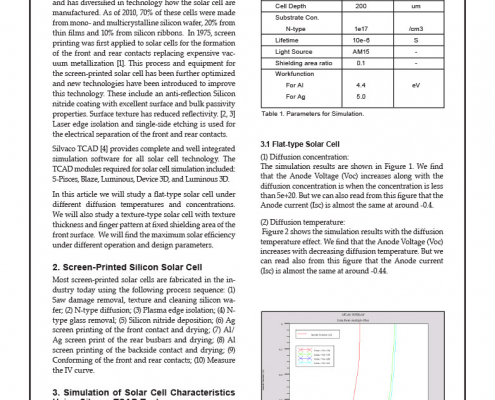
The Studies of Regular Texture Thickness and Finger Pattern of the Front Surface by Using Silvaco TCAD Tools
The photovoltaic industry has rapidly grown since 2000 and has diversified in technology how the solar cell are manufactured. As of 2010, 70% of these cells were made from mono- and multicrystalline silicon wafer, 20% from thin films and 10% from silicon ribbons. In 1975, screen printing was first applied to solar cells for the formation of the front and rear contacts replacing expensive vacuum metallization [1]. This process and equipment for the screen-printed solar cell has been further optimized and new technologies have been introduced to improve this technology. These include an anti-reflection Silicon nitride coating with excellent surface and bulk passivity properties. Surface texture has reduced reflectivity. [2, 3] Laser edge isolation and single-side etching is used for the electrical separation of the front and rear contacts.
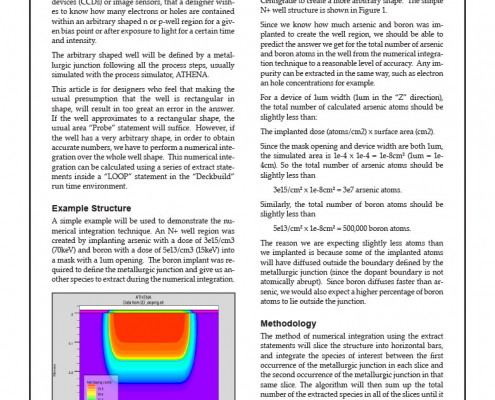
Extracting Concentrations from Arbitrary Shaped Well Regions
It is often the case when simulating charged coupled devices (CCDs) or image sensors, that a designer wishes to know how many electrons or holes are contained within an arbitrary shaped n or p-well region for a given bias point or after exposure to light for a certain time and intensity.
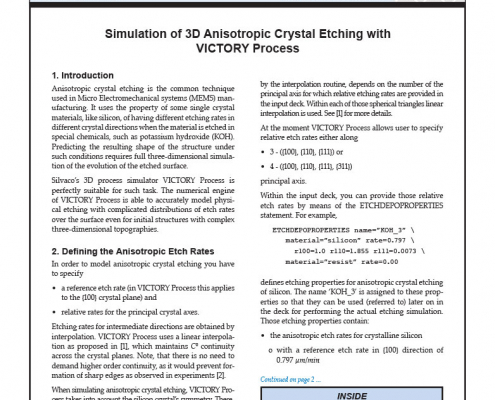
Simulation of 3D Anisotropic Crystal Etching with VICTORY Process
Anisotropic crystal etching is the common technique used in Micro Electromechanical systems (MEMS) manufacturing. It uses the property of some single crystal materials, like silicon, of having different etching rates in different crystal directions when the material is etched in special chemicals, such as potassium hydroxide (KOH). Predicting the resulting shape of the structure under such conditions requires full three-dimensional simulation of the evolution of the etched surface.
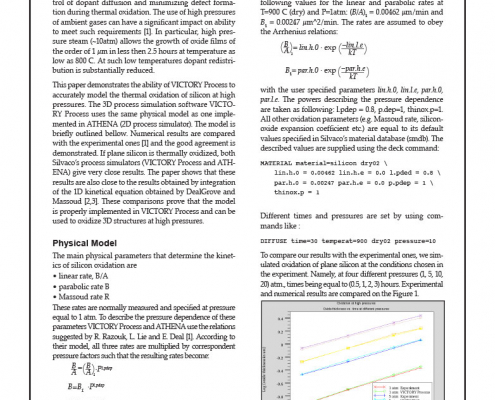
Using VICTORY Process to Simulate Thermal Oxidation of Silicon at High Pressures of Ambient Gases
Developing ULSI silicon technology requires good control of dopant diffusion and minimizing defect formation during thermal oxidation. The use of high pressures of ambient gases can have a significant impact on ability to meet such requirements [1]. In particular, high pressure steam (~10atm) allows the growth of oxide films of the order of 1 μm in less then 2.5 hours at temperature as low as 800 C. At such low temperatures dopant redistribution is substantially reduced.
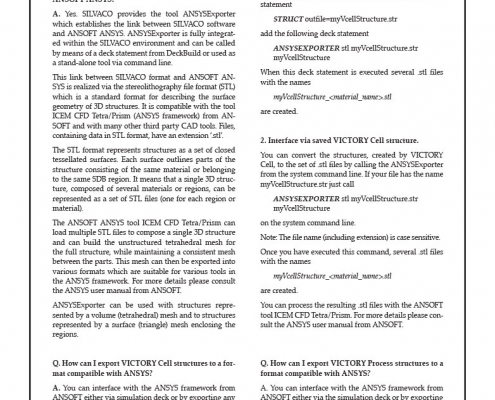
Hints, Tips, and Solutions – Export 3D Structures from VICTORY Cell/Process to ANSOFT ANSYS
SILVACO provides the tool ANSYSExporter which establishes the link between SILVACO software and ANSOFT ANSYS. ANSYSExporter is fully integrated within the SILVACO environment and can be called by means of a deck statement from DeckBuild or used as a stand-alone tool via command line.
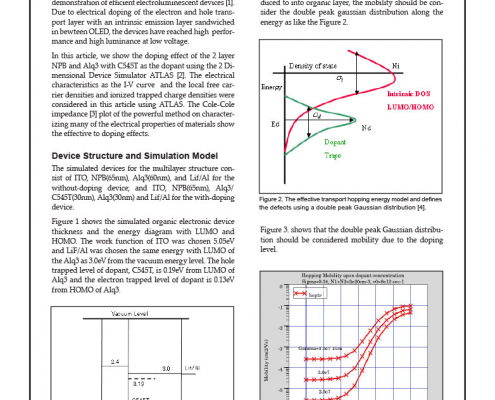
The Doping Effect Simulation on the OLED Devices Using ATLAS
Organic light emitting diodes (OLEDs) have attracted great attention for full-color flat-panel displays since the demonstration of efficient electroluminescent devices [1]. Due to electrical doping of the electron and hole transport layer with an intrinsic emission layer sandwiched in bewteen OLED, the devices have reached high performance and high luminance at low voltage.
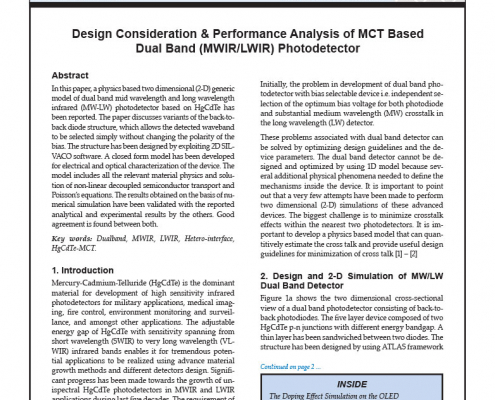
Design Consideration & Performance Analysis of MCT Based Dual Band (MWIR/LWIR) Photodetector
In this paper, a physics based two dimensional (2-D) generic model of dual band mid wavelength and long wavelength infrared (MW-LW) photodetector based on HgCdTe has been reported. The paper discusses variants of the back-to-back diode structure, which allows the detected waveband to be selected simply without changing the polarity of the bias. The structure has been designed by exploiting 2D SILVACO software. A closed form model has been developed for electrical and optical characterization of the device. The model includes all the relevant material physics and solution of non-linear decoupled semiconductor transport and Poisson’s equations. The results obtained on the basis of numerical simulation have been validated with the reported analytical and experimental results by the others. Good agreement is found between both.
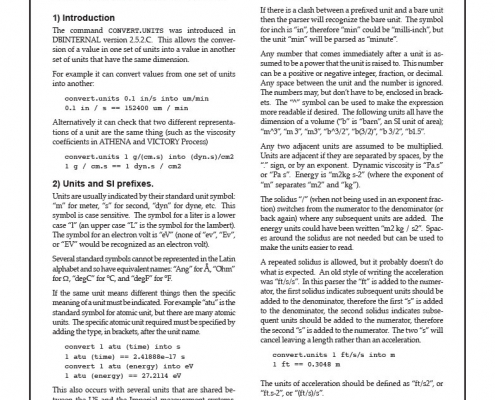
Hints, Tips, and Solutions – Conversion to Different Units
Q. How do I convert a value from one set of units into another?
A. Use the DBINTERNAL CONVERT.UNITS command.
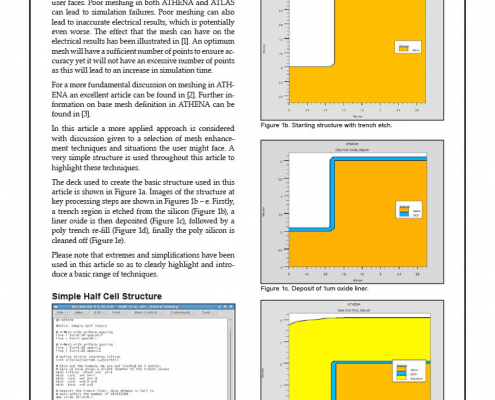
How to Mesh in 2D TCAD
Meshing for process in ATHENA or electrical characterisation in ATLAS is one of the biggest challenges that a user faces. Poor meshing in both ATHENA and ATLAS can lead to simulation failures. Poor meshing can also lead to inaccurate electrical results, which is potentially even worse. The effect that the mesh can have on the electrical results has been illustrated in [1]. An optimum mesh will have a sufficient number of points to ensure accuracy yet it will not have an excessive number of points as this will lead to an increase in simulation time.
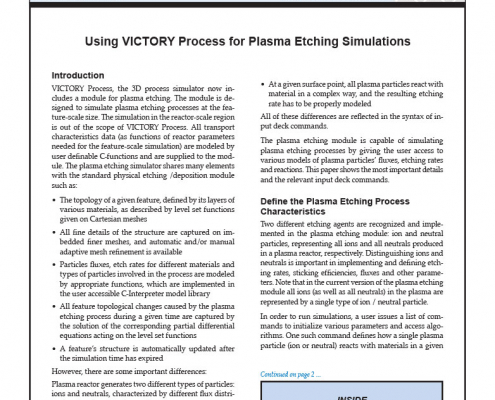
Using VICTORY Process for Plasma Etching Simulations
VICTORY Process, the 3D process simulator now includes a module for plasma etching. The module is designed to simulate plasma etching processes at the feature-scale size. The simulation in the reactor-scale region is out of the scope of VICTORY Process. All transport characteristics data (as functions of reactor parameters needed for the feature-scale simulation) are modeled by user definable C-functions and are supplied to the module. The plasma etching simulator shares many elements with the standard physical etching /deposition module such as:
